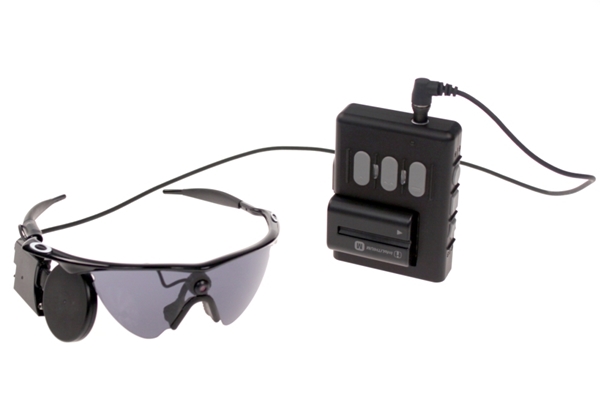25 July 2016. An electronic device implanted in retinas of people with retinitis pigmentosa, a progressive eye disorder leading to blindness, shows after 5 years the device continues to provide some visual function to recipients, largely without adverse effects. The team from Second Sight Medical Products in Sylmar, California that makes the Argus II Retinal Prosthesis System reported its findings last week in the journal Ophthalmology.
Retinitis pigmentosa is an eye disease caused by genetic defects that damages cells affecting night vision, and sometimes peripheral and central vision, in the retina, leading to blindness. The retina is the layer of tissue at the back of the inner eye that converts light images to nerve signals and sends them to the brain. The condition affects 1 in 2,700 people, or about 100,000 in the U.S.
The Argus II uses a tiny video camera mounted on glasses to capture images that are then transformed with a processing unit and sensors into electronic signals sent to the retina to produce images. The system restores perception of light and movement, not full eyesight, and is intended for adults age 25 or older with advanced cases of retinitis pigmentosa. To receive the system, patients must have an intact and functioning inner retinal layer, and previous history of the ability to see forms.
The clinical trial enrolled 30 individuals with retinitis pigmentosa at 10 locations in the U.S. and Europe. In the study, participants were tracked over a 5 year period looking particularly at safety indicators — number and seriousness of adverse events related to the device — and visual function, as measured by 3 computer-based tests. In addition, researchers evaluated the quality of life of the Argus II recipients, daily activities, orientation, and mobility, as well as stability of the implant and functionality of the device.
The new results show after 5 years participants are more successful in performing the three visual function tests — of object detection, motion detection, and visual acuity — with the Argus II turned on than switched off. Only some of the secondary outcome data on day-to-day functioning with the device were collected, but those results show people with the Argus II can follow a white line on a black tile floor and find a simulated door with the device turned on rather than switched off.
The safety data show of the original 30 implants, 3 needed to be removed due to mechanical irritation or pressure in in the eye, or voluntarily elected by the recipients. For 2 other individuals, the device failed, but they did not experience other safety issues as a result. Of the 30 recipients, 18 experienced no adverse effects from the surgery or use of the device. The remaining 12 participants reported 24 adverse events, mainly eye irritation or pressure. No eyes were lost during the trial, and 1 participant died of causes unrelated to the device.
Earlier results of the trial provided evidence for regulatory authorities to approve the system for marketing in the U.S. and Europe. The company says nearly 200 people are using the device, and a feasibility study is in the works for extending the Argus II system to individuals with dry age-related macular degeneration.
Read more:
- Machine Learning Harnessed for Mobile Eye Tracker
- New Diabetic Eye Disease Drugs Shown Not Cost-Effective
- Regeneron, Bayer Collaborating on Eye Disorder Drug
- Eye Disease Gene Defect Repaired with CRISPR
- Researchers Develop Eye Injury Test, Start Company
* * *


 RSS - Posts
RSS - Posts
You must be logged in to post a comment.